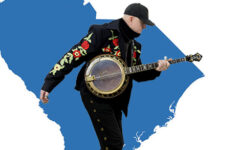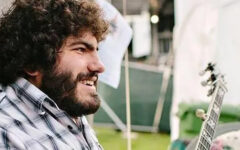 From October 1, 2010 through to the end of September 2011, we will, each day, celebrate the life of Bill Monroe by sharing information about him and those people who are associated with his life and music career. This information will include births and deaths; recording sessions; single, LP and CD release dates; and other interesting tidbits. Richard F. Thompson is responsible for the research and compilation of this information. We invite readers to share any tidbits, photos or memories you would like us to include.
From October 1, 2010 through to the end of September 2011, we will, each day, celebrate the life of Bill Monroe by sharing information about him and those people who are associated with his life and music career. This information will include births and deaths; recording sessions; single, LP and CD release dates; and other interesting tidbits. Richard F. Thompson is responsible for the research and compilation of this information. We invite readers to share any tidbits, photos or memories you would like us to include.
- September 9, 1966 Bill Monroe and the Blue Grass Boys appeared at the Philadelphia Folk Festival.
- September 9, 1996 Bill Monroe died at the Northcrest Home and Hospice Center, Springfield, Tennessee. He was just a few days from his 85th birthday. *
- September 9, 2003 DVD released – The Legend Lives On – A Tribute to Bill Monroe (Koch Vision KOC DV 6156). **
- September 9, 2011 Workshop – The Country Music Hall of Fame and Museum and IBMA hosted a teacher workshop focussing on Bill Monroe and the practical ways for elementary and middle school teachers to share information about bluegrass music with their students. ***
 * Bill Monroe passed from this earth 15 years ago today after a 6-month-long illness.
* Bill Monroe passed from this earth 15 years ago today after a 6-month-long illness.
Monroe was an extraordinary man; some elevate him to an even higher status. Hype aside, he was very strong, physically and mentally, but he had his weaknesses, both physical and mental.
He immersed himself in his music; did he really pluck notes – those ancient tones – from out of the air? Notes that he heard in the wind as it blew around his little cabin home or in the pines?
Slowly Monroe graduated from being a steadfast pioneer to someone who Ralph Rinzler describes as a “mellow patriarch.” He never ceased to be innovative with his music, as his recording catalog indicates, and he began to wear the mantle of the ‘Father of Bluegrass Music’ easier as each year passed.
His legacy, both his personal and that which has evolved through the music of the many bluegrass musicians that were influenced, directly or indirectly, by him, is enjoyed worldwide.
Bill Monroe has gone but his music lives on.
Belatedly (this piece should have been posted last month), here is a memory that musician John Keith shares …..
“It was August 9, 1996 and The Goins Brothers were heading home from their annual trip to Hugo, Oklahoma. Melvin had us stop in Nashville on the chance we could visit Big Mon at the rehabilitation center where he was then a resident.
We were all eager to see him and very disappointed when word came after our arrival there, that only Melvin was permitted to see him. It was understandable, but disappointing nonetheless.
A very nice young lady who worked there, and, who evidently had some pull, saw our disappointment.
She instructed us to go to the bus and get our instruments and follow her through the courtyard. She pointed to an open window and told us to “casually” make are way in that direction. As we peered in the window, they had Bill setting up and were giving him his glasses.
We kicked off Uncle Pen – John McNeely with the big G-run, Buddy Griffin on fiddle, Melvin and Dave Baker on guitar and bass respectively, and myself on mandolin – and he smiled like I had never seen him smile before. We stood outside his window and played for thirty minutes or so, all Bill Monroe songs, of course. When we finished he thanked us and told us to ‘Keep playing that bluegrass.’
That was the last time I saw Bill Monroe, and like the first time, I shall never forget it.”
John Keith has played mandolin with Melvin Goins since 1990.
** The Legend Lives On – A Tribute to Bill Monroe, 158 minutes; 2 discs
The father of bluegrass is feted by peers, protégés, and spiritual descendants in this concert film, set in Nashville and featuring 15 country artists and groups performing Monroe’s classic songs. The two-disc The Legend Lives On reaches deep into the heart of Monroe’s canon with Ricky Scaggs’s (sic) cover of Uncle Pen (named for Pendleton Vandiver, the family member who taught Monroe to play his trademark mandolin). Sparks fly with the populous Del McCoury Band’s take on John Henry, Charlie Daniels’s propulsive Rollin’ in My Sweet Baby’s Arms, and Marty Stuart’s Raw Hide, complete with sweet bluesy preface. Connie Smith and the Whites pair up for a satisfying gospel excursion, Walkin’ in Jerusalem, Ralph Stanley and the Virginia Mountain Boys mix-and-match lovely bluegrass textures, a bouncing beat, and plaintive vocals in the fascinating Can’t You Hear Me Callin’, and soloist Tim O’Brien is superb on the stark Highway of Sorrow.
Tom Keogh
Track listing – Uncle Pen – Ricky Skaggs & Kentucky Thunder; Cross Eyed Child – John Hartford; John Henry – Del McCoury Band; Walkin’ to Jerusalem – Connie Smith & the Whites; Raw Hide – Marty Stuart with Del McCoury Band; Can’t You Hear Me Callin’ – Ralph Stanley; Rose of Old Kentucky – Larry Sparks; Highway of Sorrow – Tim O’Brien; Wicked Path Of Sin – Jerry & Tammy Sullivan; Orange Blossom Special – Charlie Daniels; Rocky Road Blues – Jim & Jesse; Blue Eyed Darlin’ – The Bluegrass (sic) Boys; Blue Moon of Kentucky – James Monroe; Will the Circle Be Unbroken – All Artists
Rabbit in the Log – Marty Stuart; True Life Blues – Del McCoury Band; What Would You Give in Exchange – Larry Sparks, Ricky Skaggs & Kentucky Thunder; Used to Be – The Whites; Swing Low Sweet Chariot – Bill Carlisle; Rollin’ In My Sweet Baby’s Arms – Charlie Daniels; I Got a Letter – Ralph Stanley; In the Pines – The Bluegrass (sic) Boys; Workin’ on a Building – Tim O’Brien; I’ll Meet You in Church Sunday Morning – Jerry & Tammy Sullivan; Little Cabin on the Hill – John Hartford; Bean Blossom Memories – James Monroe; I’ll Fly Away / I Saw The Light – All Artists
*** The workshop took place at the Country Music Hall of Fame and Museum in Nashville.
It was designed to assist all levels within teaching establishments; including administrators, curriculum specialists and college students majoring in education.
The schedule included an introduction to the Foundation for Bluegrass Music DVD, Discover Bluegrass, and the Country Music Hall of Fame and Museum’s Shapes, Sound Holes, and Strings program; live instrument demonstrations; clogging lessons; and a participatory workshop on bluegrass harmony singing.
This event was an extension to the IBMA’s Bluegrass in the Schools program and an acknowledgement of Bill Monroe’s role as a teacher.







